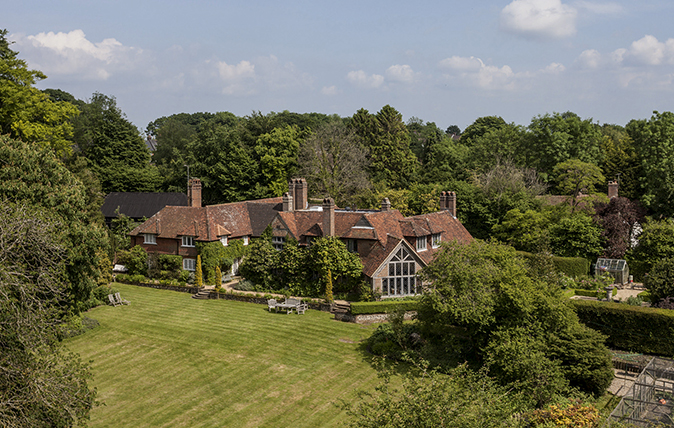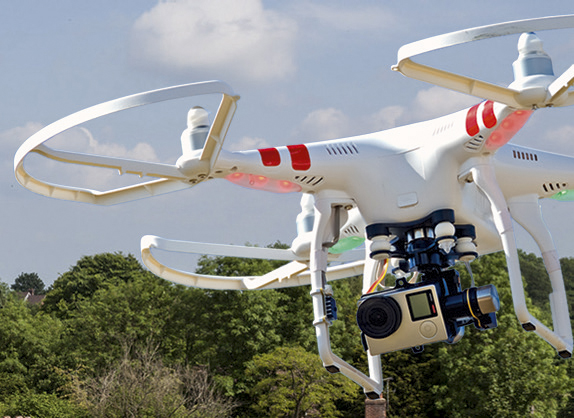Virtual reality: The future of property viewings?
With the advent of drone photography and virtual-reality headsets, digital developments are affecting the way we buy and sell country houses.


It’s a sunny morning and light floods the elegant Hollywood property I’m viewing. I walk past the designer kitchen towards the vast, contemporary living room, where one wall is taken up by sliding glass doors. As I go out onto the terrace, Los Angeles stretches at my feet. Except that I’m not in Hollywood. I’m at Strutt & Parker’s Hill Street London offices and my tour of this rather grand Californian mansion comes courtesy of a Virtual Reality (VR) headset that Kevin Powell, who heads up the firm’s digital department, has just lent me.
Strutt & Parker have recently begun using VR to bring their properties to buyers across the world. Their 360-degree models not only show you what a house looks like, but also give you a sense of the space and flow of rooms. ‘The headsets allow people to view a property without having to get on a plane,’ says Mr Powell. ‘Our agents are currently in Dubai with headsets loaded with the show flats of the new development at the former BBC Television Centre and we’ll have other agents going to America in a short while.’
The response has been overwhelmingly positive, says Mr Powell, and not just among buyers: ‘When we demonstrate it, vendors are really positive. We’re currently working with clients who are privately selling a £30 million house in the country and they have been very enthusiastic. Of course, we always work in full consultation with them to respect their privacy and security by, for example, taking significant artwork off the walls or storing valuables before filming.’
VR is perhaps the most cutting-edge example of how technology is revolutionising the way estate agents showcase properties, but it’s by no means the only one. It plays into the growing desire among buyers to acquire as much information about a property as possible before a viewing. ‘They do their own research, but the more you can give them, the happier they are,’ says James Cleland, head of Knight Frank’s Ascot office.
Last year, Strutt & Parker rolled out 3D models of top-end properties, which they then loaded onto a dedicated brochure website complete with a video and a high-resolution photo gallery. This allowed prospective buyers to take a virtual tour of a house, taking in details such as door handles, bathroom fittings, ceiling heights and room volumes, which don’t always emerge clearly through photographs.
Similarly, Savills creates individual websites for top country houses where even the typeface is specifically picked ‘so that people can really visualise the property’, according to Crispin Holborow, Country Director of the company’s Private Office. They provide an effective way to present houses that are only available on a private and confidential basis. ‘It has been very successful—we’ve sold a significant number of properties in the past two-and-a-half years.’
The centrepiece in these websites is often a gallery of high-resolution images and a video shot by a drone. Indeed, drones may have been the single most important technological improvement to property marketing in the past few years. For starters, they have made it easier to take pictures in difficult contexts. ‘A country house in an elevated position can be hard to photograph,’ notes Mr Holborow. ‘Photographers need to get their camera on a very long pole, but even that sometimes doesn’t work. Drones solve this because they can go higher.’
Sign up for the Country Life Newsletter
Exquisite houses, the beauty of Nature, and how to get the most from your life, straight to your inbox.
A drone can also capture a property’s wow factor in a way a normal picture doesn’t. ‘Being able to have an aerial view and showcase in a moving image the setting of a house—or how the kitchen garden relates to the coach house—just brings a property to life.’
Drones are so successful that they are increasingly becoming part of the regular marketing package. ‘I bet that if you flick through the pages of an edition of COUNTRY LIFE from five years ago and one from this year, the quality of the photography now is much better,’ says Mr Cleland. To prove his point, he goes through the property advertisements in an issue from last August: ‘I reckon that at least half of them— if not most of them—are drone pictures.’
Ultimately, the future of property marketing lies in tools that reflect a property as realistically as possible, benefiting both buyers and vendors. ‘You want a situation where buyers can see on screen what they would see in real life,’ adds Mr Cleland. ‘We’re not there yet, but we’re heading in that direction.’

Tech know-how
- High-quality equipment is key to a successful VR experience. Strutt & Parker partnered with Matterport, whose cameras calculate spatial data within the property, as well as taking both motion and still pictures
- With drone videos, good filming by a professional is crucial, advises Mr Holborow
- As for editing, Savills keeps its videos down to 45 seconds—after that, ‘people switch off’
Carla must be the only Italian that finds the English weather more congenial than her native country’s sunshine. An antique herself, she became Country Life’s Arts & Antiques editor in 2023 having previously covered, as a freelance journalist, heritage, conservation, history and property stories, for which she won a couple of awards. Her musical taste has never evolved past Puccini and she spends most of her time immersed in any century before the 20th.
-
 Designer's Room: A solid oak French kitchen that's been cleverly engineered to last
Designer's Room: A solid oak French kitchen that's been cleverly engineered to lastKitchen and joinery specialist Artichoke had several clever tricks to deal with the fact that natural wood expands and contracts.
By Amelia Thorpe Published
-
 Chocolate eggs, bunnies and the Resurrection: Country Life Quiz of the Day, April 18, 2025
Chocolate eggs, bunnies and the Resurrection: Country Life Quiz of the Day, April 18, 2025Friday's quiz is an Easter special.
By James Fisher Published
